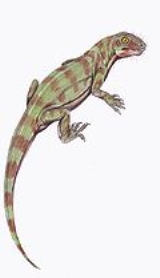
Dromasauria
Encyclopedia
Dromasaurs are a paraphyletic group of anomodont
therapsids from the Middle Permian. They were small with slender legs long tails. Their skulls were short, but the eye sockets were large. Dromasauria was once considered to be a major group of basal
anomodonts along with the infraorder Venyukovioidea
. It includes the genera Galepus
, Galechirus
, and Galeops
, all from southern Africa
. Below is a cladogram
based on Modesto and Rubidge (2000), Liu et al. (2009) and Cisneros et al. (2011):

Anomodont
The Anomodontia were a major group of therapsids, an extinct group of animals commonly known as "mammal-like reptiles." They were mostly toothless herbivores. During the Middle Permian they were very diverse, including groups like the Venyukovioidea, the Dromasauria, the Dicynodontia, and early...
therapsids from the Middle Permian. They were small with slender legs long tails. Their skulls were short, but the eye sockets were large. Dromasauria was once considered to be a major group of basal
Basal (phylogenetics)
In phylogenetics, a basal clade is the earliest clade to branch in a larger clade; it appears at the base of a cladogram.A basal group forms an outgroup to the rest of the clade, such as in the following example:...
anomodonts along with the infraorder Venyukovioidea
Venyukovioidea
Venyukovioidea is an infraorder of anomodont therapsids from the Permian of Russia. It includes the genera Otsheria, Venyukovia, Ulemica, and Suminia. Venyukovioidea and Dromasauria were traditionally considered the two main groups of basal anomodonts. Dromasauria was considered a Gondwanan group...
. It includes the genera Galepus
Galepus
Galepus is an extinct genus of therapsid....
, Galechirus
Galechirus
Galechirus is an extinct genus of therapsid mammal-like reptile. It was about 30 cm long.This lizard-like creature is considered to be a dicynodont by some paleontologists; others think Galechirus is the young of a larger therapsid genus. Judging from its teeth, it was an insectivore....
, and Galeops
Galeops
Galeops is an extinct genus of therapsid....
, all from southern Africa
Africa
Africa is the world's second largest and second most populous continent, after Asia. At about 30.2 million km² including adjacent islands, it covers 6% of the Earth's total surface area and 20.4% of the total land area...
. Below is a cladogram
Cladogram
A cladogram is a diagram used in cladistics which shows ancestral relations between organisms, to represent the evolutionary tree of life. Although traditionally such cladograms were generated largely on the basis of morphological characters, DNA and RNA sequencing data and computational...
based on Modesto and Rubidge (2000), Liu et al. (2009) and Cisneros et al. (2011):


